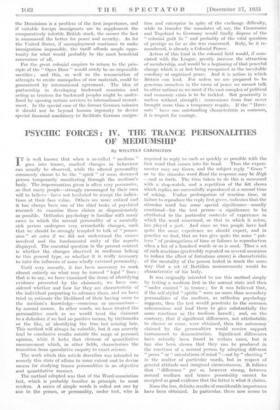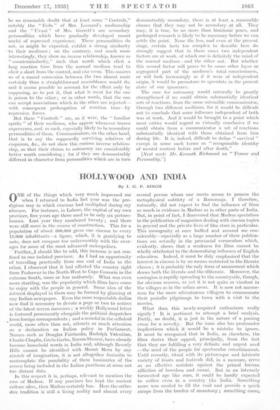PSYCHIC FORCES: IV. THE TRANCE PERSONALITIES OF MEDIUMSHIP
By WHATELY CARINGTON
I T is well known that when a so-called " medium " goes into trance, marked changes in behaviour can usually be observed, while the altered personality commonly claims to be the " spirit " of some deceased person temporarily manifesting through the medium's body. The impersonation given is often very persuasive, so that many people—strongly encouraged by their own will to believe—have not hesitated to accept the indica- tions at their face value. Others are more critical and it has always been one of the chief tasks of psychical research to examine these claims as dispassionately as possible. Orthodox psychology is familiar with many eases in which the normal personality of a mentally sick person undergoes very remarkable changes, such that we should .be. strongly tempted to talk of "posses- sion" at' extra if we did not understand the causes involved and the fundamental unity of the aspects displayed. The essential question in the present context is whether the changes observed in mediums belong to this general type, or whether it is really necessary to infer the influence of some wholly external personality.
Until very recently, it has been necessary to work almost entirely on what may be termed " legal " lines ; that is to say, we have examined the items of identifying evidence presented , by the claimants, we have con- sidered whether and how far they are characteristic of the individual purporting to advance them, and we have tried to estimate the likelihood of their having come to the medium's knowledge—conscious or unconscious-- by normal means. In other words, we .have dented the personalities much as we would treat the claimant to a dukedom if we had no positive means, by birthmarks or the like, of identifying the true but missing heir. This method will always be valuable, but it can scarcely lead to conclusive results outside the range of personal opinion, while it lacks that element of quantitative measurement which, in other fields, characterises the transition from speculative enquiry to exact science.
The work which this article describes was intended to remedy this state of affairs to some extent and to devise means for studying trance personalities in an objective and quantitative manner.
The method adopted was that of the Word-association test, which is probably familiar in- principle to most readers. A series of simple words is Called out one by one to the person, or personality, under test, who is required to reply to each as quickly as possible with the first word that comes into his head. ' Thus the experi- menter may say Green, and the subject reply " Grass or to the stimulus word Road the response may be High --and so forth. The time taken to do this is measured with a stop-watch, and a repetition of the list shows which replies are successfully reproduced at a second time of asking. Undue prolongation of reaction Aline,. or failure to reproduce the reply first given, indicates that the stimulus ,word has some special significance—usually emotional—for the test person—A significance to bp attributed to the particular contexts of. experience in which the word concerned, or that to which it refers, has played a part. And since no two people have had quite the same experience we should expect, and in practice we find, that no two give quite the same "pat- tern " of prolongations of time or failures in reproduction when a list of a hundred words or so is used. .Thua a set of such reactions (preferably repeated on several,opeasions to reduce the effect of fortuitous errors) is characteristic of the mentality of the person tested in much the same way that a set of. Bertillon measurements would be characteristic of his body.
It was originally intended to use this method simply by testing a medium first in the normal state and then "under control " in trance ; for it was believed thati if the self-styled " spirits " were no. more than secondary personalities of the medium, as orthodox psychology suggests, then the test would penetrate to the common subconscious and lead themto give substantially the same reactions as the medium herself ; and, on the contrary, that if significant differences, not attributable to chance or error, were obtained, then the autonomy claimed by the personalities would receive support tantamount to demonstration. Significant differences have actually been found in certain cases, but it has also been shown that they can be produced in the reactions of a normal person by adopting different " poses " or "orientations of mind "—not by " cheating " . in the matter of particular words, but in respect of general attitude and imagined circumstances. It follows that " difference " per se, however strong, between normal medium and trance personality cannot be accepted as good evidence that the latter is what it claims.
None the less, definite results of considerable importance have been obtained. In particular. there now . seems to be no reasonable doubt that at least some "Controls," notably the " Feda " of • Mrs. Leonard's mediumship and the , ." Uvani " of Mrs. Garrett's are secondary personalities . which have gradually developed round nuclei of repressed experience. These personalities do not, as might be expected, , exhibit a strong similarity to, their mediums ; on the contrary, and much more interestingly, they show an inverse relationship, known as ",countersimilarity," such that words which elicit a long reaction time from the normal medium tend to elicit a short from the control, and vice versa. This assures us of a causal connexion between the two almost more certainly than a straightforward resemblance would do, and it seems possible to account for the effect only by supposiag, so to put. it, that what is meat for the one is poison to the other ; or in other words, that the one can accept. associations which in the other are rejected— with consequent prolongation of reaction time--by repressive forces.
But these " Controls " are, as it were, the "familiar spirits " of their mediums, who appear whenever trance supervenes, and, as such, especially likely to be .secondary personalities of them. Communicators, on the other hand, that is to say the supposedly surviving relatives of enquirers, &c., do not show this curious inverse relation- ship, so that their claims to autonomy are considerably better worth considering ; . for if they are demonstrably different in character from personalities Which are in turn demonstrably secondary, there is at least. a, reasonable chance that they may not be secondary ;gt, al, They may, it is true, be no more than histrionic poses,- and prolonged research is likely to be necessary before we can settle the point. .None the less,, and even at the present stage, certain facts too complex to describe here do strongly suggest that in these eases two independent factors are at work, of which one is definitely the mind, of the normal medium—and the other not. But whether this second factor will prove to be some other layer or segregated part of the medium's total consciousness, or will look increasingly as if it were of independent origin, it would be premature to speculate in the present state of our ignorance. • The case for autonomy would naturally be greatly strengthened if we could obtain substantially identical sets of reactions, from the same ostensible communicator, through two different mediums, for it would be difficult not to conclude that some influence independent of both was at work. And it would be brought to a point which most critics would regard as virtually conclusive if we could obtain from a communicator a set of reactions substantially identical with those obtained from him during life. It is, indeed, difficult to define " survival " except in some such terms as "recognisable identity of -mental content before and after death."
[Next week: Mr. Kenneth Richmond on "Trance and Personality."]



































 Previous page
Previous page